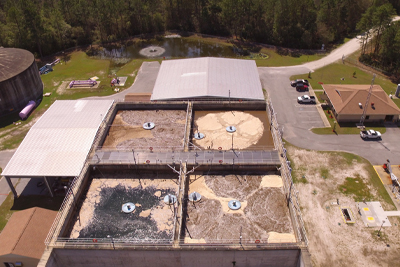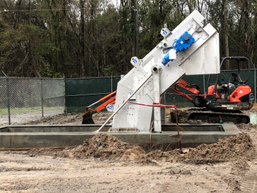Wastewater Collection and Treatment
Simonton Engineering’s experience ranges from small private systems to large Urban area systems.
- Collection – The task include evaluating the area to determine the best means of collecting the wastewater, preparing design of the system along with transporting the wastewater to the treatment location then designing the most efficient process and system to treat the wastewater to permit limits. Collection system design begins by evaluating the best method to collect the wastewater from each house or business, of course a gravity collection system is always the preferred method, but in some cases a low pressure system is required.
- Pumping Stations – The pumping facilities are custom designed for the system and the preferences of the client. Energy efficiency is a key point of consideration in the design of the station.
- Treatment – Wastewater treatment systems, designed in the past, range for 100,000 GPD aerated lagoons with land application systems to 7.15 MGD Sequential Batch Reactor (SBR) systems. Our process experience has also included Biological Nitrogen Removal (BNR) systems as well as conventional activated sludge plants.
Case Studies:

Problem: The City of Hinesville shared ownership of the Ft. Stewart Wastewater Treatment Plant with the military. The growth in the City had pushed its use of the facility beyond its allocated capacity. To accommodate an additional brigade being transferred to Ft. Stewart the Government notified the city it could no longer use more than their allocated capacity in the plant. The capacity needed to be available for the additional troop strength in a very short time frame.
Engineered Solution: The answer to the problem was a new plant constructed under a hybrid between a “Design Build” and a “Design, Bid, Build” Concept. The new plant was sited, permitted, built and placed into service in 30 months.
In addition to implementing a three-basin AquaSBR treatment process, Simonton Engineering and the City of Hinesville developed a system capable of producing and delivering reuse water to customers all around the city. By treating wastewater to reuse standards, the City of Hinesville is lowering their dependence on potable water, reducing water withdrawal from the city’s aquifers, and further supporting sustainable growth in Coastal Georgia.
Problem: In 2009 the City of Hinesville was notified that the new NPDES permit for the Ft. Stewart plant would have new limits to comply with a recently completed TMDL. The permit effluent limit concentrations were reduced to half of the old plant design limits.
Engineered Solution: Knowing that the existing plant would not be able to consistently meet the new limits Simonton Engineering was given the task to evaluate the current facility and prepare a presentation outlining the alternatives to the City government and Ft. Stewart command. The recommended alternative included utilizing a portion of the plant but changing the treatment process to a four basin SBR. In an effort to utilize the existing wastewater treatment plant site, Simonton Engineering utilized the AquaSBR treatment process for its high-quality treatment standards and smaller footprint that is a result of the entire treatment process occurring within the same reactor basins. Since coming online in 2017, the Ft. Stewart WWTP has continuously produced high quality effluent without the use of chemicals. The plant is set up to tie into the reuse water system that was developed with the Hinesville WRF whenever reuse demand outgrows the WRF’s capacity. This forward-thinking mindset has allowed Simonton Engineering to help communities continue to accommodate future needs while conforming to present constraints.
Problem:
The “Hinesville Pump Station (HPS)” transports a large portion of wastewater from the city to the Regional Wastewater Treatment plant at Fort Stewart. Even though the wastewater plant has influent screens to remove solids for all wastewater entering the plant, HPS has its own screen to protect the pumps from large debri such as limbs, chunks of concrete, pieces of lumber, large bed sheets and rags. The screen was located inside of the pump station building and required manual labor to transport the collected solids to a polycart outside of the building.

Solution:
It has always been a mystery how such large material can enter the sewer collection system and get through the pipe to the pumping station?
The original HPS construction included a 27’ long fine screen spanning two floors to collect solids before entering the pump station. Due to the large debris entering the station the fine screen was constantly being damaged by large chunks of concrete, timber and other debri. The screening structure required replacement of the rotating screen about every 8 years and total replacement about every 15 to 18 years. In 2020 the screen failed again and was in need of another total replacement.
Simonton Engineering was asked to investigate the failure and recommend action to remedy the problem. As is Simonton Engineering’s approach to most problems we examined the existing installation to decide if replacement was the best long and short term solution for the City. In doing this we examine the real need and determine if it is being met by the existing application. In this case the answer was an astounding NO. We determined that the best solution was to install a much more robust piece of equipment that was designed with its primary purpose to catch the large chunks of damaging debri and lift them to the surfaced for disposal. It was also determined that the screen needed to be removed from inside of the building to make access and operation more efficient. We felt that our technical solution was solid but also needed to check the financial analysis to insure it was the best financial solution to address the problem. In comparing the alternatives, we found that the more robust screen installed outside of the building reduced the annualized capital cost plus operation of the facility by more than $4,500 per year.
The recommendation was made to the City and the project is now under construction. The screen was placed in the new outdoor channel around the first of February and should be operational by the end of the month.


